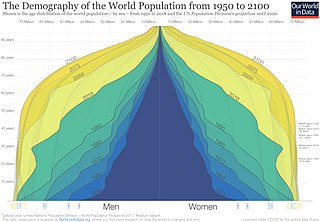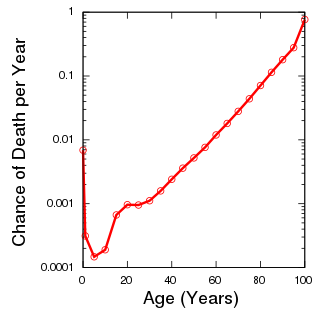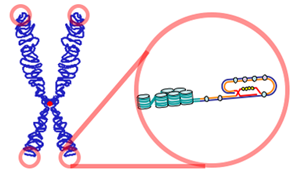The compensation law of mortality (or late-life mortality convergence) states that the relative differences in death rates between different populations of the same biological species decrease with age, because the higher initial death rates in disadvantaged populations are compensated by lower pace of mortality increase with age. The age at which this imaginary (extrapolated) convergence of mortality trajectories takes place is named the "species-specific life span" (see Gavrilov and Gavrilova, 1979). For human beings, this human species-specific life span is close to 95 years (Gavrilov and Gavrilova, 1979; 1991).
Compensation law of mortality is a paradoxical empirical observation, and it represents a challenge for methods of survival analysis based on proportionality assumption (proportional hazard models). The compensation law of mortality also represents a great challenge for many theories of aging and mortality, which usually fail to explain this phenomenon. On the other hand, the compensation law follows directly from reliability theory, when the compared systems have different initial levels of redundancy.

Demography is the statistical study of human populations: their size, composition, and how they change through the interplay of fertility (births), mortality (deaths), and migration.

Longevity may refer to especially long-lived members of a population, whereas life expectancy is defined statistically as the average number of years remaining at a given age. For example, a population's life expectancy at birth is the same as the average age at death for all people born in the same year.
Maximum life span is a measure of the maximum amount of time one or more members of a population have been observed to survive between birth and death. The term can also denote an estimate of the maximum amount of time that a member of a given species could survive between birth and death, provided circumstances that are optimal to that member's longevity.
Biological immortality is a state in which the rate of mortality from senescence is stable or decreasing, thus decoupling it from chronological age. Various unicellular and multicellular species, including some vertebrates, achieve this state either throughout their existence or after living long enough. A biologically immortal living being can still die from means other than senescence, such as through injury, poison, disease, predation, lack of available resources, or changes to environment.

The Hayflick limit, or Hayflick phenomenon, is the number of times a normal somatic, differentiated human cell population will divide before cell division stops.
Biodemography is a multidisciplinary approach, integrating biological knowledge with demographic research on human longevity and survival. Biodemographic studies are important for understanding the driving forces of the current longevity revolution, forecasting the future of human longevity, and identification of new strategies for further increase in healthy and productive life span.
The reliability theory of aging is an attempt to apply the principles of reliability theory to create a mathematical model of senescence. The theory was published in Russian by Leonid A. Gavrilov and Natalia S. Gavrilova as Biologiia prodolzhitelʹnosti zhizni in 1986, and in English translation as The Biology of Life Span: A Quantitative Approach in 1991.
The Gompertz–Makeham law states that the human death rate is the sum of an age-dependent component, which increases exponentially with age and an age-independent component. In a protected environment where external causes of death are rare, the age-independent mortality component is often negligible. In this case the formula simplifies to a Gompertz law of mortality. In 1825, Benjamin Gompertz proposed an exponential increase in death rates with age.

Alexandr Pavlovich Rasnitsyn is a Russian entomologist, expert in palaeoentomology, and Honored Scientist of the Russian Federation (2001). His scientific interests are centered on the palaeontology, phylogeny, and taxonomy of hymenopteran insects and insects in general. He has also studied broader biological problems such as evolutionary theory, the principles of phylogenetics, taxonomy, nomenclature, and palaeoecology. He has published over 300 articles and books in several languages. In August 2008 he was awarded the Distinguished Research Medal of the International Society of Hymenopterists.
Enquiry into the evolution of ageing, or aging, aims to explain why a detrimental process such as ageing would evolve, and why there is so much variability in the lifespans of organisms. The classical theories of evolution suggest that environmental factors, such as predation, accidents, disease, and/or starvation, ensure that most organisms living in natural settings will not live until old age, and so there will be very little pressure to conserve genetic changes that increase longevity. Natural selection will instead strongly favor genes which ensure early maturation and rapid reproduction, and the selection for genetic traits which promote molecular and cellular self-maintenance will decline with age for most organisms.
Following is a list of topics related to life extension:
Biodemography is the science dealing with the integration of biological theory and demography.
Abraham Zelmanov was a Soviet scientist working in the General Theory of Relativity and cosmology. He first constructed, in 1944, the complete mathematical method to calculate physical observable quantities in the General Theory of Relativity. Applying the mathematical apparatus, in the 1940s, he established the basics of the theory of inhomogeneous anisotropic universe, where he determined specific kinds of all cosmological models—scenarios of evolution—which could be theoretically conceivable for a truly inhomogeneous and anisotropic Universe in the framework of Einstein's theory.

Negligible senescence is a term coined by biogerontologist Caleb Finch to denote organisms that do not exhibit evidence of biological aging (senescence), such as measurable reductions in their reproductive capability, measurable functional decline, or rising death rates with age. There are many species where scientists have seen no increase in mortality after maturity. This may mean that the lifespan of the organism is so long that researchers' subjects have not yet lived up to the time when a measure of the species' longevity can be made. Turtles, for example, were once thought to lack senescence, but more extensive observations have found evidence of decreasing fitness with age.
Alexey Matveyevich Olovnikov was a Russian biologist. Among other things, in 1971, he was the first to recognize the problem of telomere shortening, to predict the existence of telomerase, and to suggest the telomere hypothesis of aging and the relationship of telomeres to cancer.

In gerontology, late-life mortality deceleration is the disputed theory that hazard rate increases at a decreasing rate in late life rather than increasing exponentially as in the Gompertz law.
Anatoly Petrovich Andriyashev was a Soviet and Russian ichthyologist, marine biologist, and zoogeographist, notable for his studies of marine fauna of the Arctic and the Northern Pacific.

The mutation accumulation theory of aging was first proposed by Peter Medawar in 1952 as an evolutionary explanation for biological aging and the associated decline in fitness that accompanies it. Medawar used the term 'senescence' to refer to this process. The theory explains that, in the case where harmful mutations are only expressed later in life, when reproduction has ceased and future survival is increasingly unlikely, then these mutations are likely to be unknowingly passed on to future generations. In this situation the force of natural selection will be weak, and so insufficient to consistently eliminate these mutations. Medawar posited that over time these mutations would accumulate due to genetic drift and lead to the evolution of what is now referred to as aging.
This timeline lists notable events in the history of research into senescence or biological aging, including the research and development of life extension methods, brain aging delay methods and rejuvenation.

The relationship between telomeres and longevity and changing the length of telomeres is one of the new fields of research on increasing human lifespan and even human immortality. Telomeres are sequences at the ends of chromosomes that shorten with each cell division and determine the lifespan of cells. The telomere was first discovered by biologist Hermann Joseph Muller in the early 20th century. However, experiments by Elizabeth Blackburn, Carol Greider, and Jack Szostak in the 1980s led to the successful discovery of telomerase and a better understanding of telomeres.